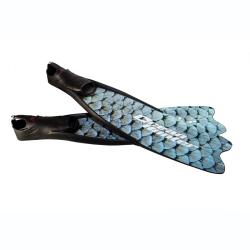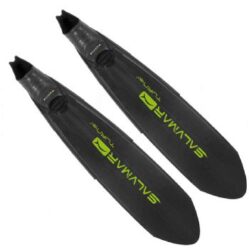Professional-Grade Scuba Fins – Effortless Underwater Propulsion
Transform your diving experience with fins engineered for maximum efficiency and comfort underwater.
Every kick underwater tells a story of efficiency or struggle. The right fins can make the difference between an immersive, enjoyable dive and a frustrating battle against the water. Our selection of premium scuba fins addresses divers' most critical challenges, delivering a smoother, more controlled underwater experience.
How Diving Fins Work
Dive fins increase a diver’s surface area in the water, allowing them to move more efficiently with each kick. The fins act like paddles, giving each leg movement greater propulsion, which helps conserve energy and swim with more speed.
Features like side rails, vents, and split blades enhance performance by reducing drag and increasing thrust. Proper fin technique—like flutter or frog kicking—boosts control and reduces fatigue, improving both safety and enjoyment underwater.
Types of Dive Fins: Open Heel vs. Full Foot
When choosing dive fins, one of the most important decisions is whether to go with open heel fins or full foot fins. Each style offers distinct advantages depending on the diving environment and your personal preferences.
Open-heel fins are designed with an adjustable strap that secures around the heel, allowing the diver to wear neoprene dive boots underneath. This setup offers excellent protection and comfort in colder water or rugged shore entries where foot protection is essential. Open heel fins are often preferred by scuba divers because they offer versatility and can be worn in a wider range of conditions. The boot-and-strap combination also provides a snug, secure fit and better power transfer from leg to fin.
Full-foot fins, on the other hand, resemble slip-on shoes and enclose the foot entirely without the need for boots. These fins are generally lighter and more streamlined, making them ideal for snorkelling or warm-water diving from boats where foot protection isn’t as critical. They’re also easier to pack and wear, especially for travel or casual dives. However, they offer less thermal insulation and can be uncomfortable on longer dives or rocky entries without added foot protection.
In summary, open heel fins offer adaptability and durability for varied conditions and are a staple for serious scuba divers, while full foot fins provide simplicity and convenience for tropical or recreational use. Choosing the right type depends on where and how you plan to dive.
Materials Used in Dive Fins
Dive fins are made from a variety of materials, each offering different levels of flexibility, durability, and performance. The three most common materials used in fin construction are rubber, plastic (polymer), and composite materials, often blending silicone, carbon fibre, or thermoplastic elastomers (TPE).
Rubber: Rubber fins are known for their weight, strength, and excellent propulsion. Because of their density, rubber fins provide powerful thrust with each kick, making them a favourite among professional divers, technical divers, and those diving in strong currents. They are also very durable and can last many years with proper care. However, their weight can be a drawback when travelling, and they may feel heavy on land or during surface swims.
Plastic/Polymer: Plastic or polymer fins are lightweight, affordable, and widely used in recreational diving. These fins are often more flexible than rubber, making them easier on the legs, especially for beginners or casual divers. They are also great for travel due to their low weight. However, plastic fins can be less durable over time and may lack the stiffness needed for high-performance diving or strong currents.
Composites (Carbon Fibre, TPE): Composite materials, such as carbon fibre blends or thermoplastic elastomers, represent the high end of fin technology. These fins are designed to offer the best of both worlds—lightweight comfort and efficient energy transfer. Carbon fibre fins are especially popular in freediving due to their incredible responsiveness and minimal drag. While these fins offer top-tier performance, they tend to be significantly more expensive and may be more prone to damage from rough handling or hard surfaces.
In conclusion, rubber fins provide durability and power but are heavy, plastic fins offer lightness and affordability but less power, and composite fins deliver high performance at a higher cost and with more care required. The right material depends on your diving style, environment, and budget.
How to Choose the Right Scuba Fins
- Effortless Propulsion: Choose designs like split fins to save energy and extend dive time.
- Fit and Style: Open-heel for rugged terrain and boots; full-foot for warm-water simplicity.
- Control and Precision: Ideal for photographers or navigating tight environments.
- Durability: Look for UV- and salt-resistant materials that last 5–7 years.
- Comfort: Features like ergonomic foot pockets and spring straps reduce fatigue.
- Adaptive Strap Systems: Our premium fins allow quick adjustments even at depth.
- Performance Materials: Dual-material designs provide better thrust with less effort.
Fit Matters: Fins and Boots Go Together
Your fins don’t just need to fit your feet — they need to fit your boots.
The best way to ensure comfort and performance is to try your fins and boots together. If you already own boots, bring them into the shop. If you're buying both, we’ll help you match them perfectly to your diving style and conditions.
Visit Us for a Proper Fit
Frequently Asked Questions
How do I maintain my diving fins? Rinse after every dive, dry completely, and store flat or hanging out of sunlight.
Can I use the same fins for snorkeling and scuba? Yes—though many divers prefer softer fins for snorkeling and stiffer ones for scuba.
How long do quality fins last? Typically 5–7 years with proper care and storage.
Are open-heel or full-foot fins better? It depends—open-heel are better for cold or shore entries; full-foot are lighter and better for travel.
Are there eco-friendly options? Yes, we offer fins made from recycled and low-impact materials.









